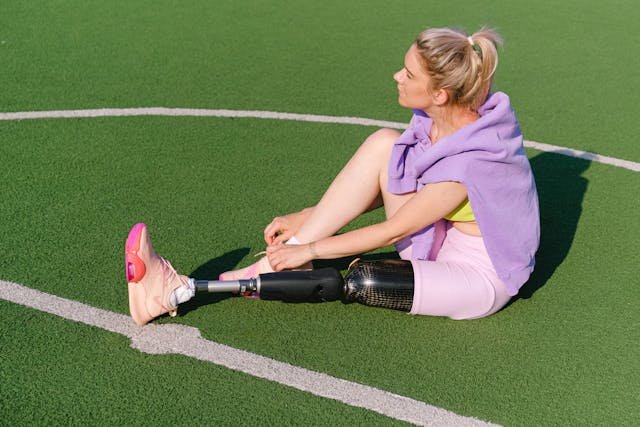When someone loses a limb, the journey to recovery begins with more than just a prosthetic fitting—it starts with the process of learning to move again. This path is different for every person, but one thing we often see at Robobionics is that individuals with a transtibial (below-knee) amputation tend to regain mobility faster than those with a transfemoral (above-knee) amputation. The reason isn’t simply about strength or determination—it has a lot to do with how the body moves, how much of the leg is still present, and how complex the prosthetic system needs to be.
Understanding these differences can help set realistic goals, offer better support, and improve outcomes for all users. In this article, we’ll take a close look at why transtibial amputees often adapt more quickly and what makes the journey slightly more complex for transfemoral users. Whether you’re just starting your rehabilitation or guiding someone through theirs, this information will help you better understand the process and take the next step forward with clarity and confidence.
The Role of the Knee in Mobility
One of the biggest reasons transtibial amputees adapt faster is because they still have their natural knee joint. The knee plays a major role in balance, control, and the overall rhythm of walking.
Keeping the Knee Means Keeping Control
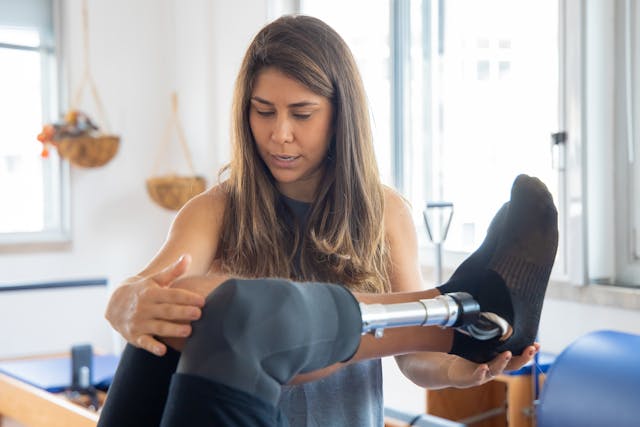
When the knee is intact, the brain and body already know how to use it. Even after an amputation, the user doesn’t need to relearn how to bend, support, or guide the leg through each step. That makes walking feel more natural, even during early prosthetic use. The body still remembers how to move with rhythm, making it easier to regain confidence quickly.
The knee helps absorb shock and adjust to changes in the walking surface. It also helps lift the foot during swing phase and control the angle during heel strike. With a functioning knee, the prosthetic foot becomes easier to control, and the user doesn’t have to rely as much on the upper body or hips for motion.
At Robobionics, we see this reflected in early rehab stages—below-knee users often walk independently within a few weeks, while above-knee users may take longer to build that same level of control and balance.
Replacing the Knee Adds Complexity
For transfemoral amputees, the loss of the knee creates an extra challenge. The prosthetic leg must now include a mechanical or electronic knee joint, which needs to be controlled by body movement. This makes walking a more conscious effort at first.
Even with advanced microprocessor knees, it takes time to learn how to shift weight, move the hip correctly, and trust the prosthetic knee to bend and support at the right moment. Many users are initially cautious or fearful, especially during slope walking or standing transitions.
Robobionics provides detailed gait training and slow step-by-step support to transfemoral users so they can build trust in their prosthetic knee. But it’s clear that adding a joint makes movement more complex, which is why the adaptation period is usually longer.
Learning New Movement Patterns
Above-knee amputees often need to learn completely new ways to move. Simple actions like sitting down, getting up from a chair, or climbing stairs all involve different muscle groups. Without the natural knee, the hips and core must do more work, and that change takes time to master.
For below-knee users, many of these movement patterns remain the same. They may need some adjustment, but the basic motion is familiar. That reduces the mental and physical strain of relearning everyday tasks, helping them adapt faster and with less frustration.
At Robobionics, we design training programs based on your specific needs. But whether you’re learning new patterns or refreshing old ones, we make sure you have the right support for every movement.
Balance and Stability from the Start
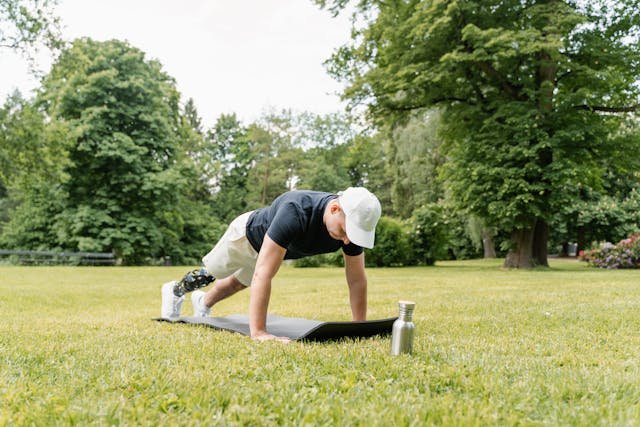
Staying balanced while standing or walking is something we often take for granted—until it becomes difficult. For prosthetic users, balance plays a key role in how quickly they regain independence.
Lower Center of Gravity Supports Balance
Transtibial prosthetic users usually have a lower center of gravity because their natural knee and thigh are still in place. This helps them stay upright more easily and control shifts in body weight during movement. It also allows them to make smaller, quicker corrections when balance is lost.
This natural advantage makes it easier to perform simple tasks like standing still, reaching down, or walking around obstacles. The less energy needed for balance, the more energy can go toward walking and daily routines.
At Robobionics, we often see below-knee users become confident walkers sooner, in part because their balance feels more secure from the beginning.
Above-Knee Users Rely More on the Hip
For transfemoral amputees, balance depends more on the strength and coordination of the hip and core. Since the thigh is shorter and the knee is mechanical, the body’s ability to make fast, natural adjustments is reduced.
This can lead to a feeling of wobbliness or uncertainty during movement. Many above-knee users describe the early days as feeling like they have to think about every step, which adds to fatigue and slows progress.
Through targeted rehab focused on hip strength and posture, our team at Robobionics helps transfemoral users improve balance. But it’s clear that the absence of the knee joint makes this part of the journey longer and more demanding.
Fear of Falling Slows Progress
Balance isn’t just about physical ability—it’s also about confidence. Transtibial users, because they feel more stable early on, tend to take more steps, try new movements, and push themselves during rehab.
Transfemoral users often feel more cautious, especially if they’ve experienced a fall or instability. This hesitation is natural but can slow progress if not addressed with encouragement and proper training.
That’s why Robobionics offers structured balance training and support tools like parallel bars and safety harnesses. Building confidence in a safe environment is key to long-term mobility, especially for those using an above-knee prosthetic.
Energy Use and Physical Effort

Walking with a prosthetic requires more energy than walking with two natural legs. But how much energy you use depends on the type of amputation and how your prosthesis is designed.
Below-Knee Users Use Less Energy to Walk
Since transtibial amputees retain their knee joint, their walking pattern remains closer to natural gait. The body doesn’t need to lift the leg as high or swing it as far to clear the ground. This means each step takes less effort and puts less strain on the rest of the body.
Over time, this reduced effort leads to less fatigue, fewer aches, and more willingness to walk longer distances. It also means below-knee users can return to work, travel, or daily routines with fewer physical limitations.
At Robobionics, we often hear below-knee users say they feel “almost normal” after a few weeks of training. That’s a strong sign that their energy use is well-managed by the prosthetic setup.
Above-Knee Walking Requires More Compensation
For transfemoral amputees, walking requires more physical compensation. The hip must lift the leg higher to move it forward, and the body must balance without help from a natural knee. This often leads to more energy use per step.
Over time, this added effort can cause fatigue in the lower back, shoulders, and sound leg. Some users develop a limp or shift their weight to avoid discomfort, which may lead to long-term joint problems if not corrected.
To reduce this, Robobionics fits transfemoral users with lightweight, energy-efficient components. We also offer advanced microprocessor knees that support better step timing and reduce the burden on the upper body.
Improved Design Helps But Doesn’t Replace Muscle Power
Even with great technology, the body still has to work hard. Smart knees and dynamic feet help reduce energy use, but they can’t replace the power of trained muscles. That’s why strength training is just as important as the prosthetic itself.
Transtibial users often regain strength faster because their movements are closer to what they already know. Transfemoral users must build new strength and movement patterns from the ground up, which naturally takes more time.
Robobionics offers strength-building rehab programs that are customized for both types of users. We focus on exercises that make movement feel easier and more sustainable, no matter your starting point.
Simpler Prosthetic Systems Lead to Faster Adaptation
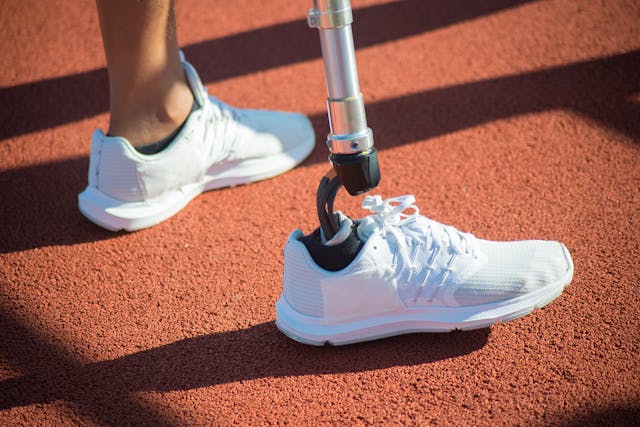
One factor that’s often overlooked in recovery is the complexity of the prosthetic itself. The more parts you have to learn, the more training it takes to use them all together smoothly.
Fewer Moving Parts Mean Less Training
A transtibial prosthetic typically includes a socket, pylon, and foot. That’s it. The user still has full control of their knee and thigh, so they only need to learn how to walk with a new foot. This keeps the learning curve short and the setup easier to maintain.
There’s less to program, fewer adjustments to make, and less chance for things to go wrong. This simplicity speeds up both physical and emotional adjustment. Users can focus more on walking and less on managing the prosthetic system.
Robobionics provides personalized fittings for each user, but below-knee setups usually take less time to fine-tune—allowing users to get back to life faster.
Complex Knees Take Time to Master
A transfemoral prosthetic includes more components: a socket, knee, pylon, and foot. The knee alone may have several settings for speed, resistance, and support. Learning how to use all these parts together takes longer—and more support from a prosthetist.
This complexity isn’t a bad thing. In fact, it allows for much better motion once the user masters it. But it does slow down the early stages of walking, especially for those who are new to using assistive technology.
That’s why we spend extra time with our transfemoral users at Robobionics. We don’t just fit the prosthetic—we train you on how to use it fully and adjust it as your movement improves.
Repairs and Adjustments Can Interrupt Training

With more components, there’s also more need for tuning and occasional repairs. A transfemoral user may need to visit the clinic more often in the first few months to make sure the knee and socket are working well together.
These visits are important, but they can slow the feeling of steady progress. In contrast, transtibial systems often require fewer follow-ups and adjustments, giving the user a smoother path forward.
At Robobionics, we reduce downtime with local repair services and remote support, so every user can keep moving with confidence—no matter how complex their prosthetic system is.
Psychological Factors That Influence Adaptation Speed
Physical differences between transtibial and transfemoral amputations are clear, but mental and emotional factors also play a big role in how quickly someone adapts. The way an individual feels about their body, their confidence, and their ability to handle change can all impact how smoothly they transition into life with a prosthetic.
Regaining a Sense of Wholeness
For transtibial amputees, the visible change to the body is often less dramatic. Since the knee and upper leg remain intact, clothing can often cover the prosthetic, and the limb may appear more “complete” to the user. This can help ease the emotional adjustment and make the person feel more like their old self again.
This sense of familiarity supports a faster mental recovery. It’s easier to accept the prosthesis as part of the body, and users may feel more open to trying new activities, returning to work, or engaging socially without hesitation.
At Robobionics, we’ve observed that this psychological comfort contributes directly to faster progress in mobility training. When users feel more whole, they’re more likely to trust the process and take the necessary steps forward.
Body Image and Self-Esteem Challenges
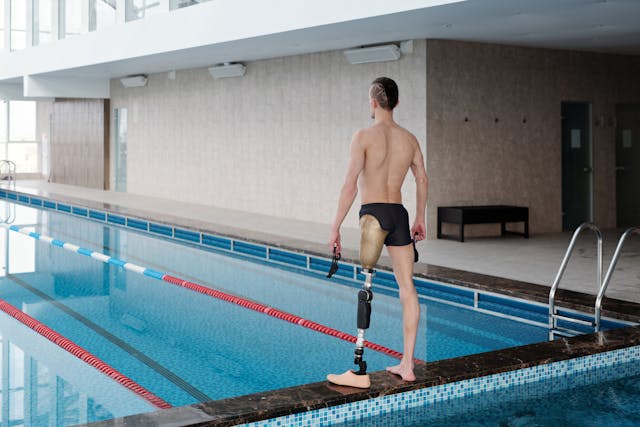
Above-knee amputees often face a more visible change in their body shape, especially when shorts or tighter clothing is worn. The prosthetic knee and thigh components can feel bulky at first, and this sometimes makes users more self-conscious about their appearance.
This emotional hurdle can slow down rehabilitation. If a user feels uncertain or embarrassed, they may hesitate to walk outside, join social events, or engage in physical activities. These delays in real-world movement limit their ability to fully adapt to the prosthetic.
That’s why Robobionics provides personalized counseling and peer support as part of our rehab programs. We help transfemoral users see that mobility is not just about how the prosthetic looks, but how it helps them live fully and independently again.
Confidence Builds with Progress
The more success someone has with their prosthetic, the more confident they become. Transtibial users often get early wins—they stand faster, walk sooner, and manage more steps with ease. These victories build confidence, which keeps motivation high.
Transfemoral users may face more ups and downs in the beginning. Progress may be slower, but every small step matters. As they start mastering balance, swing control, and knee timing, they begin to feel empowered.
At Robobionics, we track each user’s progress and celebrate every milestone. Whether it’s standing longer, walking farther, or climbing stairs independently, we make sure each success is recognized—because it’s confidence, not speed, that carries you forward in the long run.
Conclusion
Transtibial amputees often adapt faster than transfemoral amputees because they retain more of their natural leg, including the knee joint. This provides a simpler, more stable base for walking, requires less energy, and allows for easier balance and control. The physical system is less complex, and the mental adjustment can also feel more manageable. These combined advantages usually lead to quicker recovery and earlier independence.
That doesn’t mean the journey is easy—just more direct. Transfemoral users, though they face a longer and more involved path, can still achieve strong, confident mobility with the right training, support, and technology. Their recovery may take more time, but the results can be just as powerful, especially when guided by a dedicated team.
At Robobionics, we support both transtibial and transfemoral users with customized prosthetic systems, expert fittings, rehab tools, and emotional care. We understand that every person walks a different path—and we’re here to help you walk yours, step by step.
If you or a loved one is beginning the journey with a prosthetic, book a free demo or consultation with Robobionics today. Let’s find the right path forward—together.



